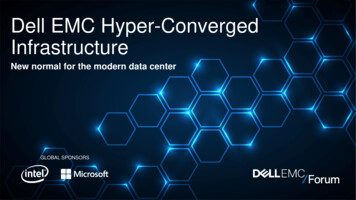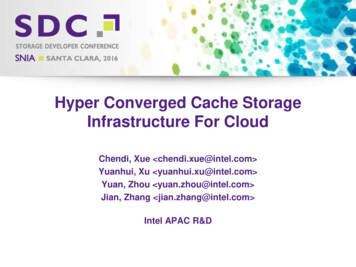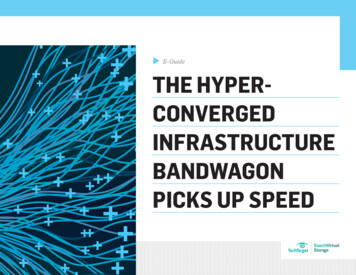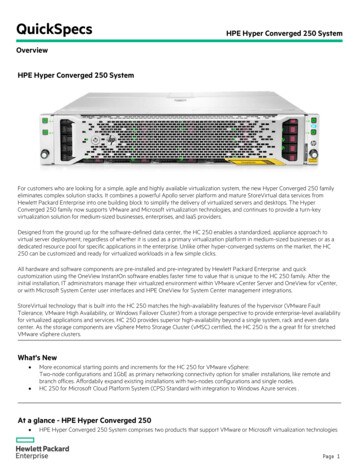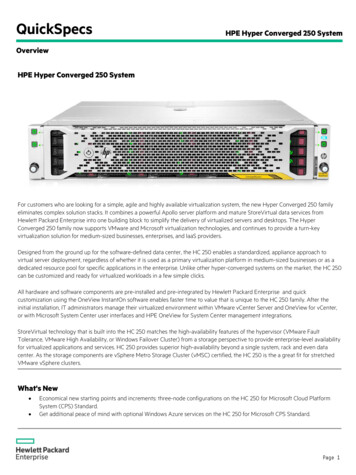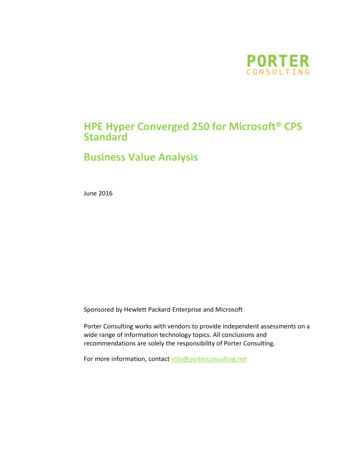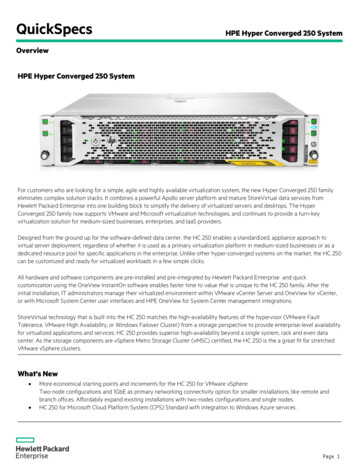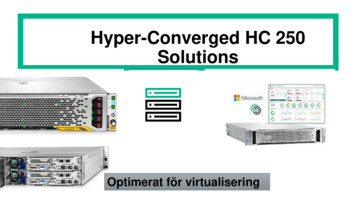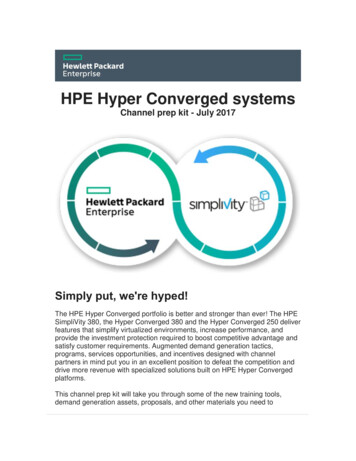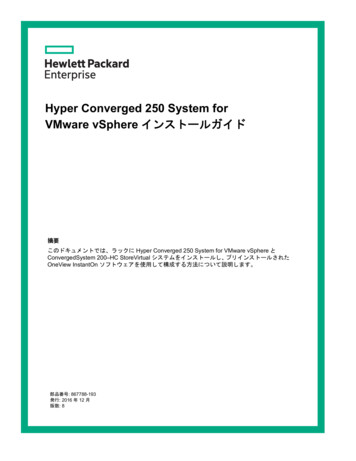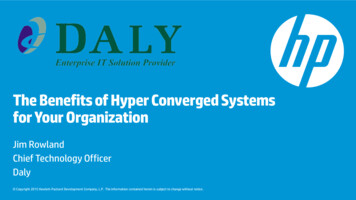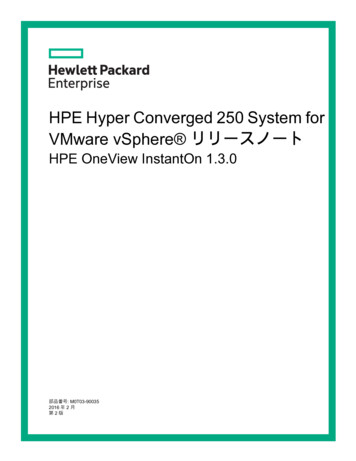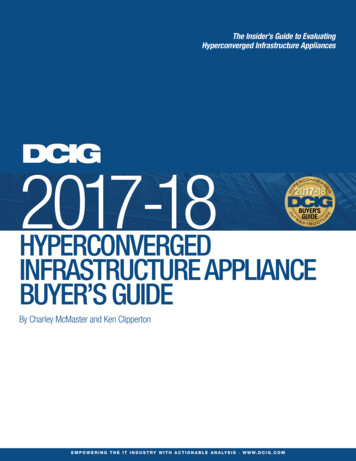
Transcription
The Insider’s Guide to EvaluatingHyperconverged Infrastructure Appliances2017-18HYPERCONVERGEDINFRASTRUCTURE APPLIANCEBUYER’S GUIDEBy Charley McMaster and Ken ClippertonE M P O W E R I N G T H E I T I N D U S T R Y W I T H A C T I O N A B L E A N A LY S I S · W W W. D C I G . C O M
2017-18 HYPERCONVERGED INFRASTRUCTURE APPLIANCE BUYER’S GUIDEThe Insider’s Guide to Evaluating Hyperconverged Infrastructure AppliancesTable of Contents135IntroductionExecutive SummaryThe Purpose of This Buyer’s Guide5How to Use this Buyer’s Guide6Disclosures6Inclusion and Exclusion Criteria7The Eight-Step Process Used toRank the Products891012DCIG Comments —The Business Valueof Hyperconverged Infrastructure8Streamlined Infrastructure8Automated Provisioning8Incremental and Customized Scaling8Hypervisor Flexibility9Data protection9Simple Adoption in the EnterpriseFeature Areas Where DCIG Expectsto See Improvement9Resource-Optimized Nodes9Rapid Adoption of NVMe9Next-generation Ethernet9Integration with Existing Infrastructure9Performance and PricingDCIG Observations10Recommended Ranking11Excellent Ranking14Hyperconverged Infrastructure Products15Dell EMC VxRail Series16Dell EMC XC630-1017Dell EMC XC6320-618Dell EMC XC730 Series19HPE Hyper Converged 250 for Microsoft CloudPlatform System Standard20HPE Hyper Converged 250 VMwarePlatform System Standard21HPE Hyper Converged 380 VMwarePlatform System Standard22HPE SimpliVity OmniCube CN-140023HPE SimpliVity OmniCube CN-240024HPE SimpliVity OmniCube CN-340025HPE SimpliVity OmniCube CN-540026HPE SimpliVity OmniStack27Lenovo HX2710-E28Lenovo HX3000 Series29Lenovo HX551030Lenovo HX751031Nutanix NX-1000 Series32Nutanix NX-3000 Series33Nutanix NX-6000 Series34Nutanix NX-8000 Series35Pivot3 Acuity X-Series36Pivot3 HCI All-Flash37Pivot3 HCI Blades38Pivot3 HCI HybridAppendicesA-1 Appendix A—Definitions, Explanations and TerminologyB-1 Appendix B—Vendor Contact InformationC-1 Appendix C—DCIG Contact InformationHyperconverged InfrastructureAppliance RankingsThis Buyer’s Guide Edition is licensed to Pivot3 with unlimited and unrestricted distribution rights through May 31, 2018. 2017 DCIG, LLC. All rights reserved.i
2017-18 HYPERCONVERGED INFRASTRUCTURE APPLIANCE BUYER’S GUIDEThe Insider’s Guide to Evaluating Hyperconverged Infrastructure AppliancesIntroductionHyperconverged infrastructure appliances (HCI) are taking the data center by storm. Thesepre-integrated solutions unite—or converge—as much of the data center infrastructure aspossible into a scale-out cluster, managed as a single entity by a single application. HCIreduces capital and operational costs through rapid deployment, non-disruptive granularscalability and simplified virtualization-centric management. Rapid deployment enablesquick time-to-value. Granular scalability and simplified management yield ongoing benefitsin agility and IT staff efficiency.At a minimum, HCI appliances combine compute, storage and data protection functions.Some HCI solutions leverage advances in software-defined networking (SDN) and networkfunction virtualization (NFV) to extend HCI management to the data center network.HCI solutions are easy to expand. The most common physical instantiation of—and unit ofscaling for—hyperconverged infrastructure is a 1U–2U rack-mountable appliance containing 1–4 cluster nodes. Simply install a new node, or multi-node appliance, and the systemdetects and aggregates the new resources. HCI eliminates the time consuming work of integrating and testing disparate technologies and enables IT teams to quickly and incrementallyincrease performance and/or storage resources to meet evolving business demands.Server virtualization technologies led the first wave of data center consolidation. Servervirtualization reduced server sprawl and improved processor utilization. However, thecomplexity of integrating disparate data protection, networking, and storage resourcesremained, along with the cost of each of these components.Advances in technology, including multi-core CPUs, high-density flash memory and inlinededuplication are enabling a new wave of consolidation, and are key drivers of the HCIrevolution. HCI leverages these advances to converge the core data center technologiesinto an appliance. HCI software melds multiple appliances into a scale-out cluster andvirtualizes the resources of the cluster to create virtual pools of these resources acrossthe entire solution. In so doing, it decouples virtual machines and their applications fromspecific physical resources.Pre-integrated data protection technologies including snapshots, backup and replicationfurther aid and simplify HCI deployment and adoption. Organizations may be able to eliminatethird-party backup software by utilizing HCI data protection features, including VM-centricbackup software that integrates with the other data protection features of the HCI solution toquickly and cost-effectively protect VMs. All the HCI solutions in this guide also integrate with3rd party backup software, enabling them to fit into existing data protection schemes.HCI solutions clearly resonate with organizations. Dell EMC reports that sales of its HCIproducts are its fastest growing line of products ever. Sales of its HCI products may surpassits converged infrastructure products as soon as 2018. A recent Gartner report predicts thatHCI will become a 5B market by 2019 up from 2B in 2016.1Clearly, hyperconverged is hot. As a result, the label is being applied to a variety ofproducts. As such, it is important to clarify how the term hyperconverged is used in thisDCIG 2017–18 Hyperconverged Infrastructure Appliance Buyer’s Guide. DCIG defines ahyperconverged infrastructure appliance (HCI) as a self-contained appliance that combinesvirtualized compute, storage and data protection functions from a single vendor with preinstalled software including hypervisor and scale-out cluster management functionality.1. “Gartner Says Hyperconverged Integrated Systems Will Be Mainstream in Five Years.”Gartner. Gartner, n.d.This Buyer’s Guide Edition is licensed to Pivot3 with unlimited and unrestricted distribution rights through May 31, 2018. 2017 DCIG, LLC. All rights reserved.1
2017-18 HYPERCONVERGED INFRASTRUCTURE APPLIANCE BUYER’S GUIDEThe Insider’s Guide to Evaluating Hyperconverged Infrastructure AppliancesIntroduction(continued)Several factors make HCI solutions appealing to organizations: Simplified management. HCI solutions provide a framework to manageservers, networking and storage without the need for multiple IT specialists,specialized training or separate administration tools. Even in distributed environments, this management framework exists where solutions in remote or branchoffices can be administered centrally. Easy expansion. HCI solutions minimize or even eliminate painful data migrations and legacy rip-and-replace methods of growth. Compute and capacity isexpanded by non-disruptively adding a new appliance or node to the cluster. Customized resource scaling. Several vendors now offer capacity- orperformance-optimized nodes allowing organizations to target upgradesto address the constrained resources. Infrastructure savings. Traditional data center solutions may require a half rackor even a full rack of equipment, including: servers, storage array and networking.Today, some HCI appliances provide a four-node solution in just two rack units.Power, cooling and space consolidation yields bottom-line savings. Simplified disaster recovery and high-availability solutions. HCI solutionsprovide fundamental disaster recovery and high-availability functionality potentiallyreducing the need for third party products.HCI solutions hold much promise through improved operational efficiencies, simplifiedmanagement purpose-built for the IT generalist and designed to grow with an organization. HCI solutions are transforming the data center by delivering a complete compute,storage and data protection solution.Charley and KenThis Buyer’s Guide Edition is licensed to Pivot3 with unlimited and unrestricted distribution rights through May 31, 2018. 2017 DCIG, LLC. All rights reserved.2
2017-18 HYPERCONVERGED INFRASTRUCTURE APPLIANCE BUYER’S GUIDEThe Insider’s Guide to Evaluating Hyperconverged Infrastructure AppliancesExecutiveSummaryIT professionals are perennially under the “do more with less” directive. This paradox leadsto a search for ways to simplify the infrastructure without sacrificing current capabilities orthe flexibility to meet future business requirements. Enter the hyperconvergence scale-outarchitecture, which is transforming the modern data center.Organizations of any size can reap the benefits of hyperconvergence. Small and midsizedbusinesses (SMBs) may use hyperconverged infrastructures to replace entire existingcompute and primary storage environments, and potentially the existing data protectionsolutions. Larger environments may benefit from HCI by replacing outdated servers andstorage arrays during the next refresh cycle. They may also choose HCI solutions atremote locations that can be centrally managed.HCI appliances integrate the compute, networking and storage of individual nodes intoa virtual pool of resources. As new nodes are brought online, the system detects andadds the new resources to the pool, effectively expanding processing, memory and storage resources in a single step. HCI software provides the virtualization, data protection,management, and orchestration services that enable the solution to be managed as asingle entity. The simplification provided by this integrated approach explains why manyCIOs and IT directors find HCI solutions intriguing.Hyperconverged infrastructures are not a panacea for every IT infrastructure need.However, for many environments, HCI offers several advantages over a siloed serverplus traditional SAN or NAS approach to data center infrastructure. Agility. Hyperconverged infrastructures provide an agile architecture that can grow(or contract) quickly as business needs dictate. Resources are added by simply installinga new node and letting the system detect and aggregate the resources then rebalancethe workloads. Frugality. Reducing costs is a major driver of HCI adoption. Hyperconverged solutionsreduce both capital and operating expenditures. CapEx Savings. HCI’s scale-out agility eliminates over-provisioning by enablingorganizations to ‘pay-as-you-grow.’ In contrast, traditional scale-up storage systemshave fixed limits on performance resources. Therefore, organizations must predictperformance requirements through the expected life of the storage system andpurchase that performance up front. As a result, traditional storage systems areoften over-provisioned, wasting valuable CapEx resources. OpEx Savings. HCI also reduces operational expenses through a reduction in rackspace, power, cooling and administration costs. Simplicity. Increasingly, organizations are utilizing IT generalists to manage infrastructureresources. HCI solutions are tailored for these environments by removing much of theinherent storage complexities found in legacy systems. This frees IT staff to focus onbusiness growth tasks.Some HCI vendors entered the market with a focus on the SMB market, or on one specialized use case such as VDI or video surveillance storage. These uses are still an excellentfit for HCI; however, HCI solutions are used for a growing number of use-cases, includingprimary enterprise workloads.This Buyer’s Guide Edition is licensed to Pivot3 with unlimited and unrestricted distribution rights through May 31, 2018. 2017 DCIG, LLC. All rights reserved.3
2017-18 HYPERCONVERGED INFRASTRUCTURE APPLIANCE BUYER’S GUIDEThe Insider’s Guide to Evaluating Hyperconverged Infrastructure AppliancesExecutive Summary(continued)Executive SummaryFive common use cases for HCI include:(continued) VDI. VDI (Virtual Desktop Infrastructure) was the initial reason many organizationsimplemented HCI. The linear scaling of compute, networking and storage in HCIsolutions matches well with VDI boot and performance requirements. ROBO. Simple deployment plus centralized administration make HCI a great fit forremote office and branch office (ROBO) installations. Data protection at ROBO locationsis often neglected. With HCI, data protection policies can be deployed across thesolution ensuring that all data is protected. Server Virtualization/Consolidation. Enterprises can reduce their data centerfootprint (rack space, power and cooling ) by consolidating separate compute andstorage components with an HCI solution. Although HCI has often been regardedas a small business or secondary storage solution, HCI vendors are now positioningtheir solutions as primary data center infrastructure suitable for even the mostdemanding enterprise applications. Dev/Test. Because of the automation and flash-enabled zero overhead cloning featuresof many HCI solutions, dev/test environments become easy to stand up and maintainwith minimal intervention from IT. Developers can utilize their own virtual machines andvirtual copies of full production datasets on the same infrastructure as the productionworkloads. Teams can work in parallel and can easily rollback to older versions withVM-level snapshots or clones. Such flexibility can shorten the development lifecycleand improve software quality. Business Continuity/Disaster Recovery. Every IT administrator cringes at the thoughtof recovering their infrastructure and data after a disaster. HCI solutions can alleviatesome of that apprehension. Some solutions support metro, or stretch, clustering withhigh availability between two physically separated sites.The DCIG 2017–18 Hyperconverged Infrastructure Appliance Buyer’s Guide accomplishesthe following objectives: Provides an objective, third party evaluation of hyperconverged infrastructureappliances that evaluates their features from an end user’s viewpoint Includes recommendations on how to best use this Buyer’s Guide andthe products contained in it Ranks the features on each product based upon the criteria that matter mostto end users so they can quickly know which products are the most appropriatefor them and under what conditions Provides a standardized one-page data sheet for each product so end userscan do quick comparisons of the features that are supported and not supportedby each productThis Buyer’s Guide Edition is licensed to Pivot3 with unlimited and unrestricted distribution rights through May 31, 2018. 2017 DCIG, LLC. All rights reserved.4
2017-18 HYPERCONVERGED INFRASTRUCTURE APPLIANCE BUYER’S GUIDEThe Insider’s Guide to Evaluating Hyperconverged Infrastructure AppliancesThe Purpose of This Buyer’s GuideDCIG Buyer’s Guide Objective A DCIG Buyer’s Guide compares products,not companies A DCIG Buyer’s Guide provides actionable information A DCIG Buyer’s Guides accelerates product researchThe Value This DCIG Buyer’s GuideCreates for BuyersLike prior DCIG Buyer’s Guides, the DCIG 2017–18Hyperconverged Infrastructure Appliance Buyer’s Guidedoes the heavy lifting for organizations as they look topurchase an HCI solution by: Identifying available products in a marketplace Delineating the features that are supported Weighting these features according towhat end users consider most important Ranking each product Creating a standardized one-page data sheetfor each productThe end result is that the DCIG 2017–18 HyperconvergedInfrastructure Appliance Buyer’s Guide drives time and costout of the product selection process by enabling prospective buyers to do “at-a-glance” comparisons between manydifferent products. By identifying a shortlist of products thatmeet their specific needs, prospective purchasers can focustheir product evaluation energies on those products andmove more quickly to the competitive bid process.Note that this Buyer’s Guide is not intended to be a substitute for bringing individual products in-house for testing.In-house testing or proof-of-concept implementations shouldstill be done, if possible, since every product will performdifferently under different application workloads and datacenter environments. We hope you find that this Buyer’sGuide meets its intended purpose in your environment.How to Use this Buyer’s GuideThis Buyer’s Guide is intended to help users accelerate theirproduct research and selection process—driving cost outof the research process while simultaneously increasingconfidence in the results. The purpose of this Buyer’s Guideis NOT intended to tell users exactly which product(s) topurchase. Rather, it is to guide them in coming up with a listof competitive products that have comparable features thatmeet their specific needs.Features, as displayed on each product data sheet, represent the opinion of DCIG. DCIG encourages and stronglyrecommends every organization verify the functionality ofthe features that are of particular interest to them beforemaking a buying decision. To help in that decision, thisBuyer’s Guide gives organizations a sense of how products compare with each other, as well as giving additionalinsight into what other product offerings are available on themarket and the specific features they offer.DCIG recommends that companies use this Buyer’s Guide inthe following seven ways:1. Eliminate the painstaking research normallyassociated with identifying a shortlist of productsthat meet their needs. This Buyer’s Guide evaluatesproducts from twenty-four (24) different products fromfive (5) different vendors. Each product is rankedRecommended or Excellent based on standarddeviation ranges. More than 100 different featureswere evaluated, so organizations only need to lookat the rankings and features to come up with ashortlist for consideration.2. Do apples-to-apples comparisons of products fromdifferent vendors. It behooves an organization to getcompetitive bids from multiple vendors. After all, whenthey compete, you win! But that tactic only works wellwhen organizations know that they are receivingcompetitive bids on products that are roughly comparable. Using this Buyer’s Guide, organizations can do abetter job of accomplishing that objective.3. Separate the apples from the oranges. Just asimportant as doing apples-to-apples comparisons isidentifying when an orange is thrown into the mix.Sometimes it is very difficult for an organization to knowif it is truly getting a good deal when bids come in fromvendors that include different products. Now organizations can refer to the rankings of each product on thisguide so they know when they are getting a good deal,a great deal or just a “so-so” one.4. Gain perspective on how products from lesswell-known vendors compare against establishedand better-known brands. There’s a built-in level ofThis Buyer’s Guide Edition is licensed to Pivot3 with unlimited and unrestricted distribution rights through May 31, 2018. 2017 DCIG, LLC. All rights reserved.5
2017-18 HYPERCONVERGED INFRASTRUCTURE APPLIANCE BUYER’S GUIDEThe Insider’s Guide to Evaluating Hyperconverged Infrastructure Appliancescomfort when buying products from well-knownvendors. There’s also a built-in resistance to buyingproducts from vendors that are perceived as unknownquantities. This Buyer’s Guide helps to remove some ofthat apprehension. Using this Buyer’s Guide, organizations can see how these products stack up.5. Normalize complex terminology. Every segmentacross industries has a proclivity to adopt acronymsand jargon that is specific to it. This Buyer’s Guide siftsthrough the acronyms and jargon and then normalizesthese terms, providing a foundation for meaningfulcomparisons. Definitions for these normalized terms areprovided in the Glossary in this Guide.6. Take advantage of standardized data sheetsto quickly compare products side-by-side. Theproduct data sheets available from the differentvendors are rarely laid out in the same way or containthe same information. Some vendors even havedata sheet formats that v
19 HPE Hyper Converged 250 for Microsoft Cloud Platform System Standard 20 HPE Hyper Converged 250 VMware Platform System Standard 21 HPE Hyper Converged 380 VMware Platform System Standard 22 HPE SimpliVity OmniCube CN-1400 23 HPE SimpliVity OmniCube CN-2400 HPE Simpl
